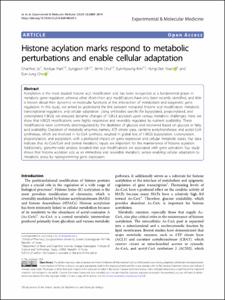Department of Brain Sciences
Lab of Neuro-Metabolism & Neurometabolomic Research Center
1. Journal Articles
Histone acylation marks respond to metabolic perturbations and enable cellular adaptation
- Title
- Histone acylation marks respond to metabolic perturbations and enable cellular adaptation
- Author(s)
- Jo, Chanhee ; Park, Seokjae ; Oh, Sungjoon ; Choi, Jinmi ; Kim, Eun-Kyoung ; Youn, Hong-Duk ; Cho, Eun-Jung
- Issued Date
- 2020-12
- Citation
- Experimental and Molecular Medicine, v.52, no.12, pp.2005 - 2019
- Type
- Article
- Keywords
- ACETYL-COA ; ACYL-COA ; SKELETAL-MUSCLE ; GENE-EXPRESSION ; CROTONYLATION ; DIFFERENTIATION ; PROPIONYLATION ; IDENTIFICATION ; PROLIFERATION ; TRANSCRIPTION
- ISSN
- 1226-3613
- Abstract
- Acetylation is the most studied histone acyl modification and has been recognized as a fundamental player in metabolic gene regulation, whereas other short-chain acyl modifications have only been recently identified, and little is known about their dynamics or molecular functions at the intersection of metabolism and epigenetic gene regulation. In this study, we aimed to understand the link between nonacetyl histone acyl modification, metabolic transcriptional regulation, and cellular adaptation. Using antibodies specific for butyrylated, propionylated, and crotonylated H3K23, we analyzed dynamic changes of H3K23 acylation upon various metabolic challenges. Here, we show that H3K23 modifications were highly responsive and reversibly regulated by nutrient availability. These modifications were commonly downregulated by the depletion of glucose and recovered based on glucose or fatty acid availability. Depletion of metabolic enzymes, namely, ATP citrate lyase, carnitine acetyltransferase, and acetyl-CoA synthetase, which are involved in Ac-CoA synthesis, resulted in global loss of H3K23 butyrylation, crotonylation, propionylation, and acetylation, with a profound impact on gene expression and cellular metabolic states. Our data indicate that Ac-CoA/CoA and central metabolic inputs are important for the maintenance of histone acylation. Additionally, genome-wide analysis revealed that acyl modifications are associated with gene activation. Our study shows that histone acylation acts as an immediate and reversible metabolic sensor enabling cellular adaptation to metabolic stress by reprogramming gene expression. © 2020, The Author(s).
- Publisher
- Springer Nature
- Related Researcher
-
-
Kim, Eun-Kyoung
- Research Interests Neural functions in metabolic diseases; 뇌신경세포와 비만; 당뇨 등의 대사 질환 관련 연구
-
- Files in This Item:
-
 기타 데이터 / 2.03 MB / Adobe PDF
download
기타 데이터 / 2.03 MB / Adobe PDF
download



